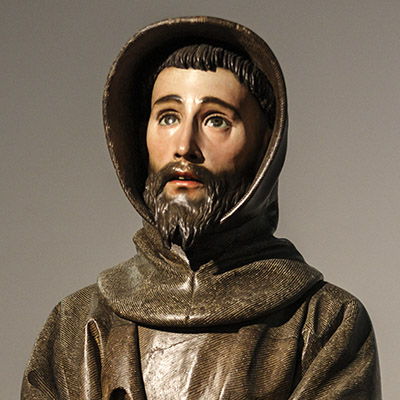Saint Francis of Assisi by Pedro de Mena y Medrano
Presiding over this room is one of the most significant works by the Granada sculptor Pedro de Mena y Medrano — Saint Francis of Assisi on the Tomb, a masterpiece of the museum’s collection, formerly kept in the parish of San Miguel (St. Michael).
The sculpture, dated between 1665-1670, life-size and made of carved and polychrome wood, represents the corpse of Saint Francis as tradition tells that Pope Nicholas V found it during his visit to the tomb of Assisi.
He is represented, therefore, incorrupt, standing, looking towards the sky, with his hood up and his hands tucked under his sleeves, while blood flows from the stigmata on his side and from the right foot that appears under the tunic. Despite what it represents, a corpse, the sensation that the viewer has is that of contemplating a mystical rapture of the saint in life. According to legend, such was the feeling that the pontiff himself experienced during his visit. (continue reading, after advertisement)
The naturalism of the entire piece is highlighted, both in the resounding verticality of the folds of the tunic, imitating in its polychrome the 'patched' tassel, and in the resources used on the face: glass eyes, natural hair eyelashes and teeth of ivory, as well as some warm and semi-matte carnations with elaborate nuances.
Due to works by the Culture Council, it was restored in 2007. On the right side of the room hangs a Zurbaranesque canvas in which Saint Francis appears kneeling in prayer. The treatment of the tunic, imitating the weaving of silk at the point of a brush and dotted with patches, shows us the close conceptual relationship that existed in Spanish art of the Golden Age between painters and image sculptors.







Comments
Post a Comment